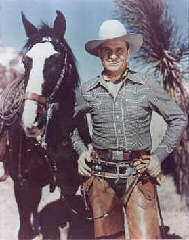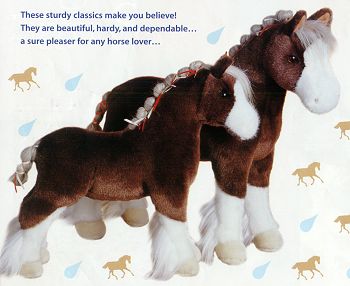|
|
You want to use body position and body language that is
noticeable to the horse to keep its attention.
Keeping a Horse's Attention
by Ron Meredith
There are probably as many jokes about getting a mule's attention
with a two-by-four as there are pickup trucks in Texas. When you
are teaching your horse to heed, you must keep bringing its
attention back to you. But you don't want to use a two-by-four.
You don't want do a lot of exciting or loud things that will
cause the horse to do a lot of exciting or loud things. You want
to use body position and body language that is noticeable to the
horse to keep its attention or send it in the direction you want.
I call this "heeding."
For example, stand at the horse's front legs with your belt
buckle facing its shoulder as you scratch the horse. Continue to
keep the line through your shoulders parallel to the horse's body
all the time you are scratching and rubbing him. If you find a
place the horse really likes being scratched, you have his
attention on you. Your goal is to captivate the horse, to keep
the horse heeding everything you do, paying attention to
everything you do. And everything you do, you do in a perceivable
pattern with a calm attitude.
Horses only pay attention to one thing at a time. Their eyes are
out on the sides of their head to see any approaching attacker
and their instincts tell them to constantly look out for those
attackers. This superb peripheral vision is what makes it so easy
to get horses to heed your body position. They can see all the
way to the back of their hindquarters with just a slight tilt of
their head. But what gets their attention keeps changing all the
time.
When their attention goes away from you, your goal is to get it
back. When something in their environment puts a question in
their mind and diverts their attention, you want them to come
back to you for the answer.
The younger a horse is the more it perceives anything sudden or
unusual as dangerous because there is less information in its
memory bank. Natural defense mechanisms and instincts are more
likely to control its behavior. So if you're teaching a really
baby horse to heed, its attention just normally darts all over
the place. It will shift its attention from one thing to another
suddenly. It will jump quickly if it notices something it didn't
see before. It will stop to observe something carefully, to take
it in completely, before it's ready to give its attention back to
you or something else and move on.
With a baby horse, your plan is to get noticed at least half of
the time and eventually the horse will develop the habit of
bringing its attention back to you. Which means that it will
start coming back to you for the answer of how to respond to that
last thing that grabbed its attention.
Gene Autry and Champion

When your horse trusts what you are saying with your body
language, heeding becomes a sort of auto pilot system. You are
calm, your horse heeds the fact that you are calm, and the horse
takes its cue from you. When you change positions, it indicates a
change in how things should be and the horse will change position
with you.
After your horse has learned to heed your body language, he will
not only heed you, but also anyone who speaks the same language.
Everything you do, as far as your position, should be horse
logical. For example, when you have your shoulder line parallel
to the horse's side then turn so your shoulder line runs through
his shoulders and step forward, the horse will automatically step
with you. You don't have to force the horse to walk and pull him
along. You also won't have to jerk on him because he's walking
too fast. He'll just start walking at the same speed you do
because you have taught him to heed your body in a horse logical
manner.
There's a corollary to having the horse pay attention to you. You
must pay attention to your horse at all times and create a calm
working environment. If someone comes along that you want to talk
to, finish with your horse, put your horse away and then talk.
Don't take your attention off your horse.
When you are cleaning the stall, you still have to pay attention
to what your horse is doing. If your horse bites, put a drop
noseband around his mouth. You can also attach a lead rope to him
and lead him around with you as you clean. Or you can put him in
a keeper stall. You must make the horse feel like doing something
you suggest without making a fight about it. That is how you gain
mental dominance.
Teaching heeding builds a communication link between yourself and
the horse in the horse's language. That is why it does not
require strength to take horses to the highest levels. There is a
MythUnderstanding that men are the best trainers because they are
stronger than women. In reality, training has nothing to do with
strength. It is about mental games. Horse training is a mental
game played in a physical medium.
Your primary objective as a trainer is rhythm and relaxation.
What the horse needs to achieve this is steady, physical work at
a mental level that you create which is alert enough to pay
attention to you but not frightened and not tense. You have to be
open minded and calm in order to study and understand. And it is
exactly the same situation with the horse.
An awful lot of people think that if they do something to the
horse that makes it act more excited, that the horse is going to
learn faster or respond better. The truth is that the horse may
not be responding at all. It may just be reacting. Reacting is
overdoing. An aid that gets a reaction instead of a response has
been avoided just as effectively as if the horse didn't respond
at all.
Never attack or punish a horse for being "disobedient." Just put
him back to work. He's just looking to have a good time and
that's what we're trying to teach him to do--to have a good time
playing our game. There is no such thing as a disobedience if
you're not telling the horse what to do. There may be a lapse of
obedience but when that happens, you simply interrupt with
instructions of what the horse ought to be doing. No fighting, no
loud or excited reaction, just a calm request using your
horse-logical communication link.
© 1997-2004 Meredith Manor International Equestrian Centre.
All rights reserved.
http://www.meredithmanor.com
Stuffed Horses - Excellent 4 Gift Ideas!

Horse Calendars that will keep your Attention
|